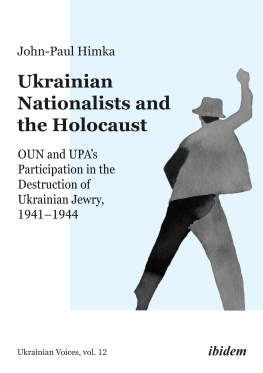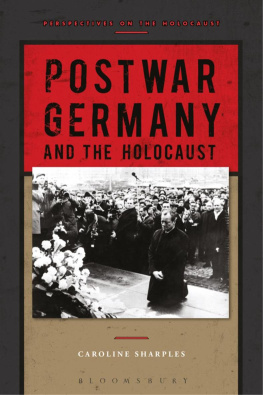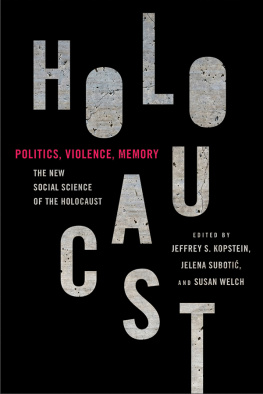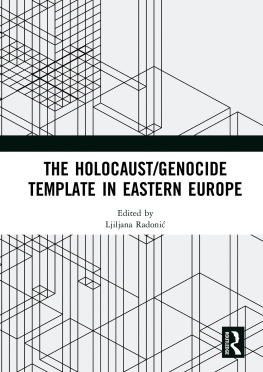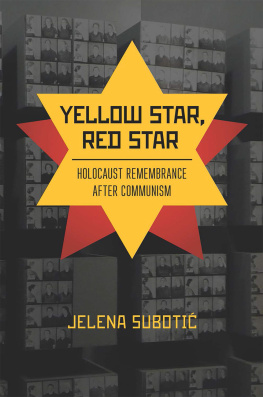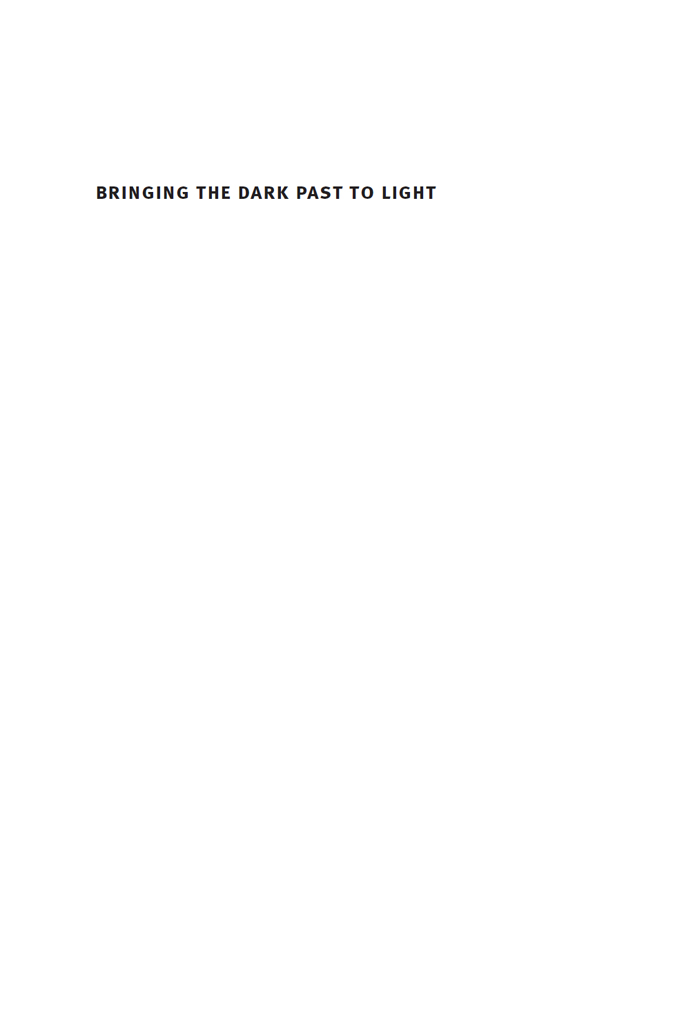

2013 by the Board of Regents of the University of Nebraska
All rights reserved
A previous version of , Victim of History:
Perceptions of the Holocaust in Estonia by Anton Weiss-Wendt, previously appeared in Journal of Baltic Studies 39,
no. 4 (2008).
Library of Congress Cataloging-in-Publication Data
Bringing the dark past to light: the reception of the Holocaust
in postcommunist Europe / edited and with an introduction
by John-Paul Himka and Joanna Beata Michlic.
pages cm
Includes bibliographical references and index.
ISBN 978-0-8032-2544-2 (cloth: alk. paper) 1. Holocaust,
Jewish (19391945)Historiography. 2. Holocaust,
Jewish(19391945)Europe, EasternInfluence. 3. Holocaust, Jewish (19391945)Public opinion. 4. Public opinion
Europe, Eastern. 5. AntisemitismEurope, Eastern.
6. Europe, EasternHistory1989 7. Europe, Eastern
Ethnic relations. I. Himka, John-Paul, 1949 editor of
compilation. II. Michlic, Joanna B., editor of compilation.
D 804.348. B 75 2013
940.53'18072047dc23 2013003571
Set in Janson Text by Laura Wellington.

Publication of this volume was
supported by a gift from Sigmund
A. Rolat and by grants from the
Holocaust Educational Foundation
and from the Conference on Jewish
Materials Claims Against Germany.
Illustrations
1. The Soviet memorial in Berlin, 1945
2. The Mahnmal at Buchenwald
3. Internal view of the Neue Wache in Berlin
4. Peter Eisenmans Memorial for the Murdered Jews of Europe
5. Examples of the Stolpersteine memorial project
6. Jews being deported from Slovakia in 1942
Preface and Acknowledgments
In 1945 few grasped the extent of the destruction of Eastern European Jews and their civilization, and the implications of this loss for the region. Among the first who mourned the loss were the Jewish survivors and eyewitnesses, as illustrated by the poem Untitled 1 of the January 1945 Novyi mir cycle by the Russian Jewish poet Ilya Ehrenburg:
I used to live in cities grand,
And love the company of the living,
But now I must dig up graves
In fields and valleys of oblivion
I speak for the dead. We shall rise,
Rattling our boneswell gothere,
Where cities, battered but still alive,
Mix bread and perfumes in the air.
Blow out the candles. Drop all the flags.
Weve come to you, not webut graves.
(Translation copyright 2011 Maxim D. Shrayer)
The Holocaust has become the European paradigm of lieu de mmoire and the universal icon of evil. Some have claimed the Holocaust an international paradigm of human rights. These developments have evolved in different directions, creating on the one hand greater understanding of the impact of the Holocaust, and on the other, poor analogies and competing narratives of martyrdom. In Europe, despite the establishment of the International Day of Holocaust Remembrance (27 January), the memory of the Holocaust still creates tensions between the West and Europes postcommunist countries. In the latter, memories of the Gulag and reluctance to come to terms with the dark wartime past, particularly as it relates to local Jewish communities, play a significant role in the ways the Holocaust is remembered.
This book aims to capture the reception and interpretation of the Holocaust in all the postcommunist countries. It examines the various stages, motivations, and nature of this dynamic process. Even as this book was being completed, the postcommunist region witnessed new developments in the memorialization of the Holocaust. For example, in Skopje, Macedonia, the Balkan Holocaust Museum opened, and in Poland a new debate erupted over Jan Tomasz Grosss latest book, Golden Harvest . This volume records all the important developments through the two decades since the collapse of communism and, we hope, it delineates the key aspects, commonalities, and divergences of the memory of the Holocaust in the region.
We would like to express our appreciation to a number of institutions and individuals that enabled us to work on this project. John-Paul Himka would like to thank the Social Sciences and Humanities Research Council of Canada and the Center for Advanced Holocaust Studies at the United States Holocaust Memorial Museum. Joanna Beata Michlic is particularly grateful to Prof. Shulamit Reinharz of the Hadassah Brandeis Institute, Brandeis University, for her support and to Prof. Yehuda Bauer for his beneficial comments. We are also deeply indebted to Mr. Sigmund Rolat, the Conference Claims Commission, and the Holocaust Educational Trust for their generosity. We would like to thank all our contributors, and especially Omer Bartov for his exhaustive afterword.
Finally, we would like to thank our editors at University of Nebraska Press for their care, support, and interest in this project, and the anonymous readers for the press who offered an invaluable critique. Last but not least, we would like to thank our families and friends for their patience and support.

Introduction
Engaging with the Dark Past
In the last two decades the subject of memory has become a compelling preoccupation of sociologists, historians, public intellectuals, and artists. The French scholar Henry Rousso has pointed out that memory has become a value reflecting the spirit of our time.
A difficult but important aspect of the study of memory is that of the dark past of nations in relation to their ethnic, religious, and national minoritiesthe ways in which nations recollect and rework the memory of their dark pasts and how this memory shapes their collective identities and the social identity of ethnic and national minorities. Discussions about national identities cannot escape from an orientation toward the past, especially the uncomfortable past, which does not pass away.on the one hand, and on the other hand, of getting the past wrong, thus making both the past and present not only bearable but also predominantly positive and bright. It demonstrates that in mainstream historical consciousness and public memory the painstakingly uncovered accounts of the dark pasts are chiefly perceived in a category of too much truth that can hardly be accepted on a larger social scale. And it shows too that in public memory, remembering is not necessarily about getting the past right, but rather about maintaining the positive collective self-image and soothing national myths. Thus, the dark past is perceived as a spoiler.
The memory of the Holocaust and the Jewish past in postcommunist Europe also has manifold practical implications for the development of national cultures and international relationships in postcommunist Europe, as well as for international relationships between the postcommunist countries and Israel and the Jewish diaspora, and between the postcommunist countries and the United States.
We had each been working on the problematic memory of the dark past when we decided to put together this volume. Joanna had already coedited a book with Antony Polonsky about the debates over the massacre of Jews at Jedwabne on 10 July 1940 in Poland and had just finished her monograph Polands Threatening Other , which dealt with Polish images of Jews from the 1880s until the early twenty-first century. John-Paul was near the beginning of a research project on Ukrainians and the Holocaust in history and memory and was working out some of his ideas about Ukrainian Holocaust memory at conferences. We realized that we were working on problems that exhibited many striking similarities. We also read with interest the work of other scholars on how the Holocaust was being remembered (or forgotten) in the Central and Eastern European countries making the transition out of communism. It would be very fruitful, we thought, to bring together a collection of interpretive surveys of the struggle with the memory of the Shoah in every postcommunist country in Europe, addressing a wide array of developments throughout the region.
Next page

